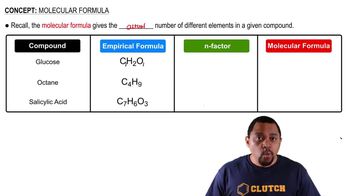Textbook Question
The molecular formula of allicin, the compound responsible for the characteristic smell of garlic, is C6H10OS2. (d) How many S atoms are present in 5.00 mg of allicin?
 Verified step by step guidance
Verified step by step guidance



The molecular formula of allicin, the compound responsible for the characteristic smell of garlic, is C6H10OS2. (d) How many S atoms are present in 5.00 mg of allicin?
The molecular formula of aspartame, the artificial sweetener marketed as NutraSweet®, is C14H18N2O5. (a) What is the molar mass of aspartame?
The molecular formula of aspartame, the artificial sweetener marketed as NutraSweet®, is C14H18N2O5. (c) How many molecules of aspartame are present in 1.00 mg of aspartame?
A sample of glucose, C6H12O6, contains 1.250×1021 carbon atoms. (c) How many moles of glucose does it contain?
A sample of the male sex hormone testosterone, C19H28O2, contains 3.88×1021 hydrogen atoms. (b) How many molecules of testosterone does it contain?